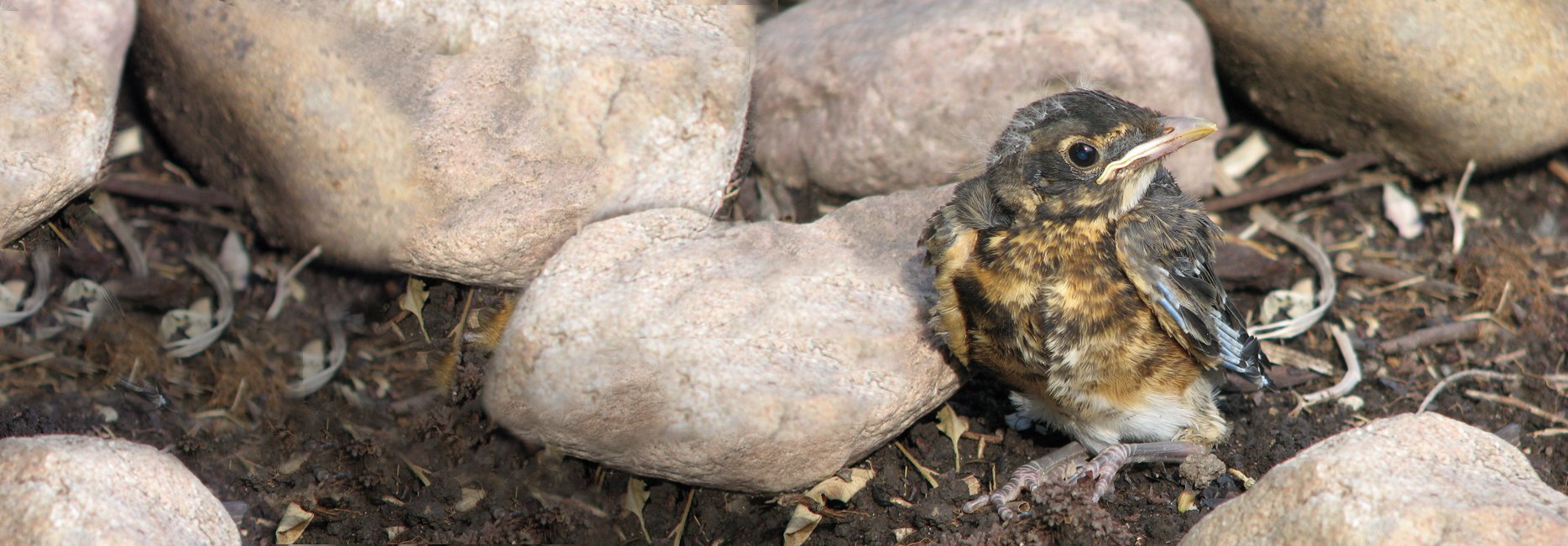
BIRDS
BIRDS BITTEN BY A CAT OR DOG
Any bird that has been in the mouth of a cat or dog needs help. Place the bird in a cloth-lined box or container with a source of heat and bring it to one of to one of Hope for Wildlife's drop off locations.
BIRDS FOUND ON THE GROUND
The first thing to do if you come across a grounded bird is determine whether the bird is a nestling or a fledgling. Let the young bird grip your finger. Is it gripping firmly? If so, it is probably a fledgling. The best thing to do is get it out of harm’s way by moving it to a protected area close by (like under a nearby tree or shrub) and leave it alone.
FLEDGLINGS
Many birds found on the ground in spring and summer are actually doing what’s called “fledging” - they cannot fly yet, or cannot fly well. As part of their normal development, all birds go from the nest to the ground (not the nest to the sky). At this fledgling stage, they are still dependent on their parents who typically stay close by (but out of sight), monitoring their progress, keeping them fed, and teaching them to be self-reliant. It is very important not to “birdnap” a fledgling and break up the family unit.
-
It is normal for a young crow to be unable to fly. Fledgling crows may look very similar to adults, but there are some indicators of a youngster:
blue eyes (adults have black eyes)
short wing and tail feathers (adults have long feathers)
ability to hop or run, and maybe even fly short distances
attempt to get away when approached (trying to go unnoticed; adults will fly away)
fairly easy to approach (protective parents or siblings may call out or swoop at "intruders;" adults are generally not approachable at all unless injured)
-
Fledgling songbirds may look very similar to adults, but there are some indicators of a youngster:
short wing and tail feathers (adults have long, smooth feathers)
remaining bits of visible down especially on head and underparts
wide fleshy sides at the base of the beak (called "gape flanges," these are absent on adults)
ability to hop or run, and maybe even fly short distances
attempt to get away when approached (trying to go unnoticed; adults will fly away)
protective parents calling out or swooping at "intruders"
-
Common indicators of fledgling owls:
Owlets will leave the nest 6-8 weeks after hatching
They will start to have adult colouring but will still have plenty of down feathers on their head and some regions of their body giving them a fluffy appearance
Fledglings will often spend a long period of time on the ground (sometime up to a week) while they figure out their wings but they will often climb up onto the low lying tree branches and have even been known to climb the trees themselves
scan the trees nearby and see if you can spot the nest and the parents, don't get too close because it is very likely the parents are close by and will be trying to protect their baby if something gets too close
If you notice any blood, an obvious wing droop, one or both eyes closed shut, or they have been in the same spot for 12-24hrs with no sign of the parents, please call our wildlife hotline.
NESTLINGS
Some birds found on the ground in spring and summer are “nestlings” that have fallen out of the nest. They are not yet ready to spend time on the ground as fledglings and should be returned to the nest if at all possible. It is a myth that a baby bird touched by humans will be rejected by its mother.
If the nest is intact and accessible, simply place the nestling(s) back into the nest. If the whole nest has fallen or been destroyed, place the nestling(s) together in a container lined with dry leaves, grass, pine needles, or the old nest itself. Poke holes into the bottom of the container for drainage, and secure it in its original location or a nearby tree. Monitor the nest from a distance to see if the parents return, and if they don't arrive within an hour, bring the nestling(s) to one of Hope for Wildlife's drop off locations.
-
Indicators of a nestling crow are:
short wing and tail feathers
ability to hop or run, and maybe even fly short distances
flying/running away when approached (trying to go unnoticed)
fairly easy to approach (protective parents or siblings may call out or swoop at "intruders")
-
Fledgling songbirds may look very similar to adults, but there are some indicators of a youngster:
short wing and tail feathers
remaining bits of visible down especially on head and underparts
wide fleshy sides at the base of the beak (called "gape flanges")
ability to hop or run, and maybe even fly short distances
flying/running away when approached (trying to go unnoticed)
protective parents calling out or swooping at "intruders"
-
Common indicators of a nestling owl:
They are covered in down feathers
They have no flight feathers and don't resemble the adults feather patterns
They often have a high pitched squealing sound as they beg for food when they see motion
They are very dependent on their parents and will spend much of their time sitting or laying down in the nest.
